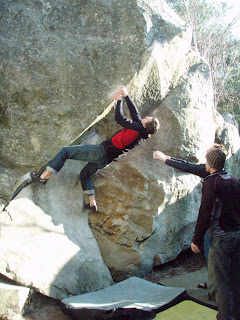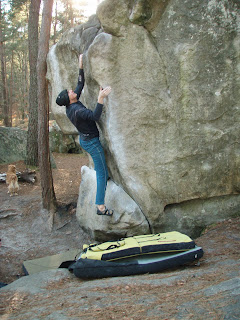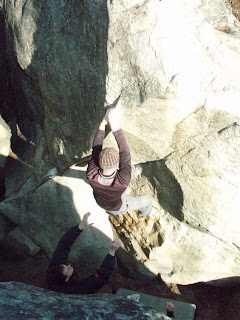First, we went up the prominent col in front of the lifts near the Luisin. We traversed to the col on the other side without going for the summit (S4 descent). From there we saw the col de Fontanabran on the opposite side of the valley and a beautiful, virgin of ski traces yet, descent we'd follow the next day. Not to mention Mont Blanc and Grand Combin in the distance.
Here is Renaud with our next objective of the day - col de Susanfe on the right of the picture:

The descent was in good snow and practically alone. That was the sign of things to come on this surprisingly lonely tour. Afterwards, unfortunately, we had to go up col de Susanfe - just after the traverse of the frozen Lac de Sanenfe (no i don't know what love affair these people have with the 'nfe' sound there...). Not difficult, but long in the end of the day, the col lead us to the Cabane de Susanfe, a lonely refuge in the middle of the valley. The mountains reminded me of the Rockies with their limestone faces half covered with snow and hanging glaciers.
The next day saw us up that hanging Ruan glacier, an unpleasant going up, using ski crampons most of the way, sometimes carrying skis through the rock passages and making our laborious progress without traces and just a map - not always that clear. Finally up the col between Grand Mont Ruan and Tour Saliere and out of the North face, we didn't go up the summit of Saliere either, thinking more about the descent and another col we'd have to go up that day. To our surpise, the big Lac d'Emosson was far from frozen. Our itinirary mentioned a crossing of that lake, which prompted us to change a bit our plan and traverse higher up instead of going down all the way to the lake and than up our col. Lac d'Emosson and Mont Blanc in the distance.
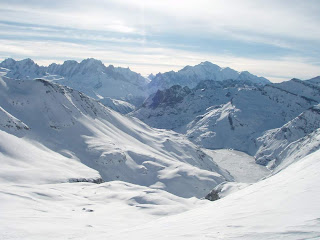
The only problem with that plan were the very South-facing slopes all around. Not exactly a place you want to be at 2 pm...There are things you have to do while ski touring or when in the mountains in general that make the heart beat go up a bit. That was one of those times. Going down an avalanche couloir to get to the normal ascent way of our col was the culmination of that. The ascent to Fontanabran was thanksfully much easier, simple ski touring diagonal curve way up affair. Due to our subterfuge traverse we gained a couple hundred meters in the ascent and respected the timing if not the avalanche safety on this one. Renaud in front, at the start of the long traverse...
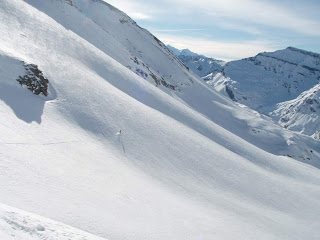
The descent on the virgin slopes was the recompense for having survived the traverse and all other pains of the day. Good powder and first traces, what could be better? Nice valley d'Emaney, with limestone towers reminding of Tre Cime in many more replicas of smaller caliber made up for the rest.
After a not so bad descent all the way to the car, we finished the outing with a drink in the ever-present Cham in a swedish bar with Olov and Magnus. Even the bar-tenders spoke Swedish - soon Cham will totally forget its french origins among the chique boutiques, exhorbitant hotels, and tourist crowds - with skis in winter, or expensive hiking boots in summer. Thanks god they stay in Cham only and leave all the other small villages alone for most of them. Let's keep the secret places secret!






